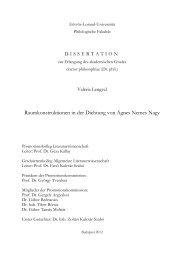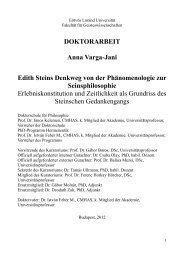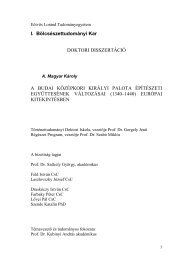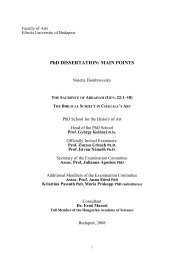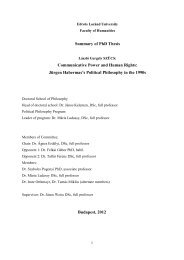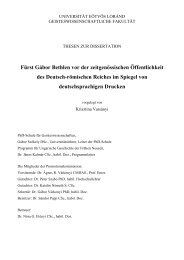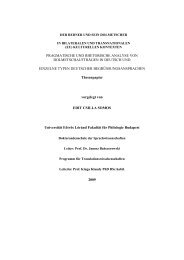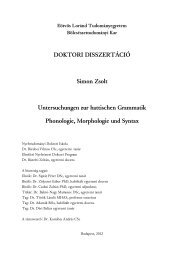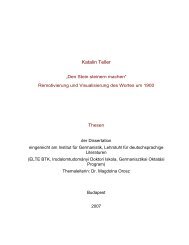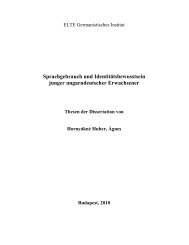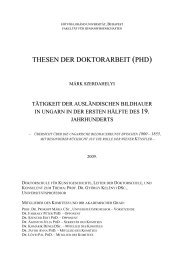Zsuzsanna Kutasi - ELTE BTK disszertációk
Zsuzsanna Kutasi - ELTE BTK disszertációk
Zsuzsanna Kutasi - ELTE BTK disszertációk
You also want an ePaper? Increase the reach of your titles
YUMPU automatically turns print PDFs into web optimized ePapers that Google loves.
Ibn al-’A‘rābī said: A man from the Banū Asad tribe was asked once if he knew the noble<br />
horse. And the man said: I can distinguish the good running steed from the lowly- descended<br />
and slow horse. As regards the swift steed, its stature is that of the wild-donkey and its walk is<br />
equal. Its gallop is extended, and if its (feet are) in fetters, it is resting on the ground quietly,<br />
and it is standing firm. Whereas the slow walked and lowly-descended horse has a sloping<br />
croup, and the tip of its nose is bulky, and its neck is thick with many scars on it. If you<br />
wanted to stop this kind of horse, it would go instead (it tells you to let it run away), and if<br />
you wanted it to go, it is halting (it asks you to stop him instead). 3<br />
ﺾﻳﺮﻌﻟا ،ثﻼﺜﻟا ﻞﻳﻮﻄﻟا : لﺎﻘﻓ ؟ﻞﻀﻓأ<br />
ﻞﻴﺨﻟا ّيأ : ﺔﻳوﺎﻌﻣ ﻪﻟﺄﺳ ﺪﻗو نﺎﺻﻮﺻ ﻦﺑ ﺔﻌﺼﻌﺻ ﻦﻋ ﺖﻠﻘﻧ ًﺎﻀﻳأ ﺔﻳﺎﻜﺤﻟا ﻩﺬهو -<br />
ﺮﻴﺼﻘﻟا ﺎﻣأو ماﺰﺤﻟاو ﻖﻨﻌﻟاو نذﻷﺎﻓ ثﻼﺜﻟا ﻞﻳﻮﻄﻟا ﺎﻣأ : لﺎﻗ . ﺎﻨﻟ ْﺮﱢﺴَﻓ : ﺔﻳوﺎﻌﻣ لﺎﻗ . ثﻼﺜﻟا ﻲﻓﺎﺼﻟا،ثﻼﺜﻟا ﺮﻴﺼﻘﻟا ،ثﻼﺜﻟا<br />
ﻦﻴﻌﻟاو ﻢﻳدﻷﺎﻓ ثﻼﺜﻟا ﻲﻓﺎﺼﻟا ﺎﻣأو . كرﻮﻟاو ﺮﺨﻨﻤﻟاو ﺔﻬﺒﺠﻟﺎﻓ ثﻼﺜﻟا ﺾﻳﺮﻌﻟا ﺎﻣأو ﺐﻴﻀﻘﻟاو ﺐﻴﺴﻌﻟاو<br />
ﺐْﻠُﺼﻟﺎﻓ ثﻼﺜﻟا<br />
. ﺮﻓﺎﺤﻟاو<br />
This story also originates from Ña‘Òa‘ b. ÑūÒān, who once asked Mu‘āwiya: Which is the<br />
best horse? He said: (It has) three long, three wide, three short and three pure (parts).<br />
Mu‘āwiya asked: Explain it us! He said: The three long (parts) are the ears, the neck and the<br />
side where the saddle 4 is. The three short are the spine, the root of the tail and the penis. The<br />
three wide is the forehead, the nostril(s) and the croup. The three pure is the skin 5 , the eye(s)<br />
and the hoof(s). 6<br />
ﺐﻴﺴﻋ ﺮﻴﺼﻗ غﺎﺳرﻷا ﺮﻴﺼﻗ ،ﺔﻴﺻﺎﻨﻟا ﻞﻳﻮﻃ بﺮﻗﻸﻟا ﻞﻳﻮﻃ ﻦﻴﻋارﺬﻟا ﻞﻳﻮﻃ ﻦﻴﻧذﻷا ﻞﻳﻮﻃ ﻖﻨﻌﻟا ﻞﻳﻮﻃ ةﺪﻴﺒﻋ ﻮﺑأ لﺎﻗ -<br />
نﺎﺒﻠﻟا ﺾﻳﺮﻋ ﺔﻬﺒﺠﻟا ﺾﻳﺮﻋ . ﺮآﺬﻟا<br />
ﻲهو ﻲﻀﻨﻟا ﺮﻴﺼﻗ قﺎﻔﺼﻟا قﻮﻓ ﺔﺒﺼﻋ ﻲهو ةﺮﻃﻷا ﺮﻴﺼﻗ ﺮﻬﻈﻟا ﺮﻴﺼﻗ ﺐﻧﺬﻟا<br />
( ﻩﺮﺧﺁ ﻰﻟإو)<br />
ﻦﻴﻧذﻷا ﻰﻨﺜﻣ ﺾﻳﺮﻋ ﻦﻴﻠﺟﺮﻟا ﻲﻔﻴﻇو ﺾﻳﺮﻋ ﻦﻳﺬﺨﻔﻟا ﺾﻳﺮﻋ مﺰﺤﻤﻟا ﺾﻳﺮﻋ<br />
Abū ‘Ubayda said: (the good horse is) long necked, long eared, long forearmed, long<br />
shanked, long forelocked, short pasterned, short rooted of its tail, short backed, short flanked,<br />
short penised, wide foreheaded, wide chested, wide haunched, wide thighed, wide cannoned<br />
on the hind legs, wide placed between the two ear-roots 7 (and so on).<br />
1.2. The description of the horse in the hippological books.<br />
3<br />
Ibn Qutayba, al-ma’ānī al-kabīr. /kitāb al-faras. Beirut 1953. vols. 3/ pp. 109.<br />
4<br />
Íizām means the girth, and if its long, it means that the side of the horse is wide. The name of this part of the<br />
horse is maÎzim.<br />
5<br />
The short, smooth haired and single coloured coat.<br />
6<br />
Al-Nuwayrī, Nihāyat al-’arab. 1933 Cairo, vols. 25/10. pp. 19.<br />
7<br />
Ibn Qutayba, al-ma‘ānī al-kabīr /kitāb al-faras. Beirut 1953. pp. 110.<br />
4



